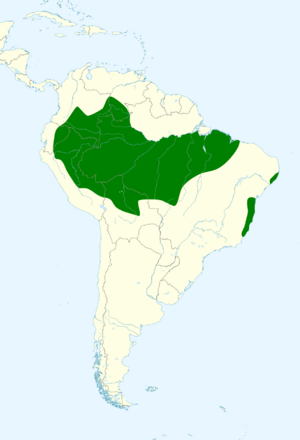Red-stained woodpecker facts for kids
Quick facts for kids Red-stained woodpecker |
|
|---|---|
 |
|
| A male at Iranduba, Amazonas state, Brazil | |
| Conservation status | |
| Scientific classification | |
| Genus: |
Veniliornis
|
| Species: |
affinis
|
 |
|
| Synonyms | |
|
Dryobates affinis |
|
The red-stained woodpecker (Veniliornis affinis) is a colorful bird that belongs to the woodpecker family. You can find these birds in several South American countries. They live in Bolivia, Brazil, Colombia, Ecuador, Peru, and Venezuela.
Contents
About Its Name
Scientists group living things into categories. This is called taxonomy. The red-stained woodpecker is usually placed in a group called Veniliornis. However, some scientists also put it in the group Dryobates. This shows that scientists sometimes have different ideas about how to best classify animals.
There are four main types, or subspecies, of the red-stained woodpecker:
- V. (or D.) a. orenocensis
- V. (or D.) a. hilaris
- V. (or D.) a. ruficeps
- V. (or D.) a. affinis
Sometimes, the hilaris and ruficeps types were even thought to be completely separate species. The Choco woodpecker was also once considered a type of red-stained woodpecker.
What It Looks Like
The red-stained woodpecker is a medium-sized bird. It is about 15 to 18 cm (5.9 to 7.1 in) long. It weighs about 32 to 44 g (1.1 to 1.6 oz), which is about as much as a few pieces of candy.
Male and female red-stained woodpeckers look very similar. The main difference is on their heads. Males have a red cap on their head. Females have a dark olive-brown cap instead.
Both sexes have a light-colored face with some olive streaks. Their neck is golden-yellow. Their back and wings are mostly yellowish-green with some red tips. They also have light yellow streaks and some bars on their lower back. Their tail is dark brown with yellowish bars.
Their belly is a light cinnamon color with dark olive-brown bars. These bars are wider apart on their lower belly. Their eyes are brown to red-brown. Their beak is blackish with a lighter lower part. Their legs are olive green to green-gray.
Young woodpeckers look like adults but have a darker face. Both young males and females have some red on their heads, but the young male has more.
Different subspecies have slight variations in color. For example, orenocensis has greener upperparts. Hilaris is larger and has more bronzy or yellow upperparts. Ruficeps is also large and has more obvious yellow streaks.
Where It Lives
The red-stained woodpecker lives in different parts of South America.
- V. (or D.) a. orenocensis lives in southeastern Colombia and southern Venezuela. It also lives in Brazil, north of the Amazon River.
- V. (or D.) a. hilaris is found in eastern Ecuador and western Brazil. It also lives south through eastern Peru into northern Bolivia.
- V. (or D.) a. ruficeps lives in central and northeastern Brazil, south of the Amazon River.
- V. (or D.) a. affinis lives in the eastern Brazilian states of Alagoas, Pernambuco, and Bahia.
These woodpeckers mostly live deep inside tall rainforests. They are less common at the edges of forests or in areas where forests have grown back. In Ecuador and Peru, they also live in wet lowland forests. Sometimes, they will even look for food in more open areas.
They can be found at different heights above sea level. In Venezuela, they live between 100 and 500 m (300 and 1,600 ft). In Colombia, they can be found up to 1,000 m (3,300 ft). In Peru, they live up to 1,300 m (4,300 ft).
Behavior
Movement
Scientists believe that the red-stained woodpecker stays in the same area all year round. It does not migrate to different places.
Feeding
This woodpecker usually looks for food in the middle and upper parts of the forest. It will sometimes come down lower at the forest edges. It often forages alone. It also joins groups of different bird species that are feeding together. Sometimes, it even follows army ant swarms to catch insects that are disturbed. Its diet includes arthropods (like insects and spiders) and fruit.
Reproduction
Not much is known about how red-stained woodpeckers reproduce. Scientists think their breeding season might be from January to September. More research is needed to learn about their nests, eggs, and how they raise their young.
Vocalization
The red-stained woodpecker does not make a lot of noise. Its main call is a series of high-pitched, nasal "ghi" or "kih" notes. It can make up to 10 to 14 of these notes in a row.
Conservation Status
The IUCN (International Union for Conservation of Nature) has listed the red-stained woodpecker as a species of "Least Concern." This means that it is not currently in danger of disappearing. It lives across a very large area. Its total population size is not known, but it is thought to be stable. There are no major threats to this bird right now. It also lives in several protected areas. Even though it's not well-known, it might be more common than people think.


